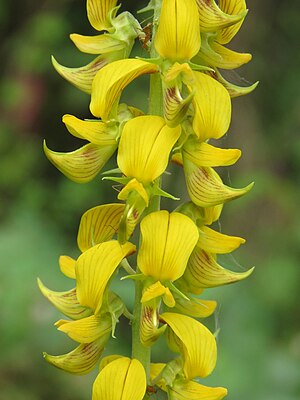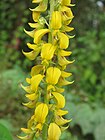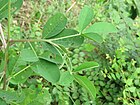Note: This is a project under development. The articles on this wiki are just being initiated and broadly incomplete. You can Help creating new pages.
Difference between revisions of "Crotalaria pallida"
(→Parts Used) |
(→External Links) |
||
| (5 intermediate revisions by the same user not shown) | |||
| Line 1: | Line 1: | ||
| − | + | [[File:Crotalaria pallida Smooth Rattlebox at Mayyil (3).jpg|thumb|right]] | |
| + | '''Crotalaria pallida''' is an erect, well-branched, sometimes robust perennial herb with stems that become more or less woody. It can grow up to 2 metres tall. The plant has a fairly long history of cultivation as a green manure and ground cover crop, though it is much less grown at present due to its susceptibility to pests and diseases in Asia. It is still often cultivated in southeastern USA. | ||
==Uses== | ==Uses== | ||
| − | {{Uses|}}, {{Uses|}}, {{Uses|}}, {{Uses|}}, {{Uses|}}, {{Uses|}}, {{Uses|}}, {{Uses| | + | {{Uses|Urinary problems}}, {{Uses|Fever}}, {{Uses|Skin infections}}, {{Uses|Thrush}}, {{Uses|Skin problems}}, {{Uses|Eczema}}, {{Uses|Swelling of joints}}, {{Uses|Wounds}}.<ref name="Uses"/> |
==Parts Used== | ==Parts Used== | ||
| Line 7: | Line 8: | ||
==Chemical Composition== | ==Chemical Composition== | ||
| − | <ref name="chemical composition"/> | + | The flavonoids apigenin and vitexin have been isolated from the bark and the leaves. Alkaloids from the seed have shown antitumor activity.<ref name="chemical composition"/> |
==Common names== | ==Common names== | ||
| Line 28: | Line 29: | ||
==Habit== | ==Habit== | ||
| − | {{Habit|}} | + | {{Habit|Perennial}} |
==Identification== | ==Identification== | ||
| Line 38: | Line 39: | ||
===Fruit=== | ===Fruit=== | ||
| − | {{Fruit|||||| | + | {{Fruit||||||Fruiting from July to January}} |
===Other features=== | ===Other features=== | ||
| Line 47: | Line 48: | ||
==Mode of Propagation== | ==Mode of Propagation== | ||
| − | {{Propagation|}} | + | {{Propagation|Seed}} |
==How to plant/cultivate== | ==How to plant/cultivate== | ||
| − | <ref name="How to plant/cultivate"/> | + | A plant of the lowland tropics and subtropics, where it has been successfully grown at elevations up to 1,800 metres. It grows in a wide range of annual rainfall conditions, from 850 mm to over 3,000 mm, and occurs occasionally in rather dry locations. The average annual temperature varies from 16 - 26°c.<ref name="How to plant/cultivate"/> |
==Commonly seen growing in areas== | ==Commonly seen growing in areas== | ||
| − | {{Commonly seen|}}, {{Commonly seen|}}, {{Commonly seen|}}, {{Commonly seen|}}, {{Commonly seen|}}. | + | {{Commonly seen|River banks}}, {{Commonly seen|Edges of lakes}}, {{Commonly seen|Extending into woodland}}, {{Commonly seen|Grassland}}, {{Commonly seen|Waste places}}. |
==Photo Gallery== | ==Photo Gallery== | ||
<gallery class="left" caption="" widths="140px" heights="140px"> | <gallery class="left" caption="" widths="140px" heights="140px"> | ||
| − | + | -86 100 Crotalaria pallida, Smooth Rattlebox (50498714758).jpg | |
| + | An insect on Crotalaria pallida.jpg | ||
| + | CHEMANCHERY5207.jpg | ||
| + | Crotalaria pallida Smooth Rattlebox at Mayyil (1).jpg | ||
| + | Crotalaria pallida (6257926179).jpg | ||
| + | Crotalaria pallida Smooth Rattlebox at Mayyil (3).jpg | ||
| + | Crotalaria pallida Smooth Rattlebox at Mayyil (15).jpg | ||
| + | Crotalaria pallida Smooth Rattlebox at Mayyil (9).jpg | ||
| + | Crotalaria pallida Smooth Rattlebox at Mayyil (8).jpg | ||
| + | Crotalaria pallida Smooth Rattlebox at Mayyil (17).jpg | ||
</gallery> | </gallery> | ||
==References== | ==References== | ||
<references> | <references> | ||
| − | |||
<ref name="chemical composition">[Chemistry]</ref> | <ref name="chemical composition">[Chemistry]</ref> | ||
| − | <ref name="Common names"> | + | <ref name="Common names">Karnataka Medicinal Plants Volume - 2 by Dr.M. R. Gurudeva, Page No. 245</ref> |
<ref name="Leaf">[Morphology]</ref> | <ref name="Leaf">[Morphology]</ref> | ||
| − | + | <ref name="How to plant/cultivate">Useful tropical plants by tropical.theferns.info website</ref> | |
| − | <ref name="How to plant/cultivate"> | ||
<ref name="Uses">Indian Medicinal Plants by C.P.Khare</ref> | <ref name="Uses">Indian Medicinal Plants by C.P.Khare</ref> | ||
</references> | </references> | ||
==External Links== | ==External Links== | ||
| − | * [ ] | + | * [https://www.anbg.gov.au/cpbr/cd-keys/RFK7/key/RFK7/Media/Html/entities/Crotalaria_pallida.htm Crotalaria pallida on anbg.gov] |
| − | * [ ] | + | * [http://www.flowersofindia.net/catalog/slides/Smooth%20Rattlepod.html Crotalaria pallida on flowers of india.net] |
| − | * [ ] | + | * [https://indiabiodiversity.org/species/show/263319 Crotalaria pallida on India bio-diversity] |
[[Category:Herbs]] | [[Category:Herbs]] | ||
Latest revision as of 10:40, 8 October 2021
Crotalaria pallida is an erect, well-branched, sometimes robust perennial herb with stems that become more or less woody. It can grow up to 2 metres tall. The plant has a fairly long history of cultivation as a green manure and ground cover crop, though it is much less grown at present due to its susceptibility to pests and diseases in Asia. It is still often cultivated in southeastern USA.
Contents
- 1 Uses
- 2 Parts Used
- 3 Chemical Composition
- 4 Common names
- 5 Properties
- 6 Habit
- 7 Identification
- 8 List of Ayurvedic medicine in which the herb is used
- 9 Where to get the saplings
- 10 Mode of Propagation
- 11 How to plant/cultivate
- 12 Commonly seen growing in areas
- 13 Photo Gallery
- 14 References
- 15 External Links
Uses
Urinary problems, Fever, Skin infections, Thrush, Skin problems, Eczema, Swelling of joints, Wounds.[1]
Parts Used
Root.
Chemical Composition
The flavonoids apigenin and vitexin have been isolated from the bark and the leaves. Alkaloids from the seed have shown antitumor activity.[2]
Common names
| Language | Common name |
|---|---|
| Kannada | ಕೂಲಿ ಮರ Koli mara |
| Hindi | |
| Malayalam | Pinkan, Punnu |
| Tamil | Cirralincil, Koli |
| Telugu | |
| Marathi | Kungin, Lokhandi |
| Gujarathi | |
| Punjabi | |
| Kashmiri | |
| Sanskrit | |
| English | Nilgiri privet |
Properties
Reference: Dravya - Substance, Rasa - Taste, Guna - Qualities, Veerya - Potency, Vipaka - Post-digesion effect, Karma - Pharmacological activity, Prabhava - Therepeutics.
Dravya
Rasa
Guna
Veerya
Vipaka
Karma
Prabhava
Habit
Identification
Leaf
| Kind | Shape | Feature |
|---|---|---|
Flower
| Type | Size | Color and composition | Stamen | More information |
|---|---|---|---|---|
| Flowering from July to January |
Fruit
| Type | Size | Mass | Appearance | Seeds | More information |
|---|---|---|---|---|---|
| Fruiting from July to January |
Other features
List of Ayurvedic medicine in which the herb is used
Where to get the saplings
Mode of Propagation
How to plant/cultivate
A plant of the lowland tropics and subtropics, where it has been successfully grown at elevations up to 1,800 metres. It grows in a wide range of annual rainfall conditions, from 850 mm to over 3,000 mm, and occurs occasionally in rather dry locations. The average annual temperature varies from 16 - 26°c.[5]
Commonly seen growing in areas
River banks, Edges of lakes, Extending into woodland, Grassland, Waste places.
Photo Gallery
References
External Links
- Ayurvedic Herbs known to be helpful to treat Urinary problems
- Ayurvedic Herbs known to be helpful to treat Fever
- Ayurvedic Herbs known to be helpful to treat Skin infections
- Ayurvedic Herbs known to be helpful to treat Thrush
- Ayurvedic Herbs known to be helpful to treat Skin problems
- Ayurvedic Herbs known to be helpful to treat Eczema
- Ayurvedic Herbs known to be helpful to treat Swelling of joints
- Ayurvedic Herbs known to be helpful to treat Wounds
- Herbs with Root used in medicine
- Herbs with common name in Kannada
- Herbs with common name in Malayalam
- Herbs with common name in Tamil
- Herbs with common name in Marathi
- Herbs with common name in English
- Habit - Perennial
- Index of Plants which can be propagated by Seed
- Herbs that are commonly seen in the region of River banks
- Herbs that are commonly seen in the region of Edges of lakes
- Herbs that are commonly seen in the region of Extending into woodland
- Herbs that are commonly seen in the region of Grassland
- Herbs that are commonly seen in the region of Waste places
- Herbs










